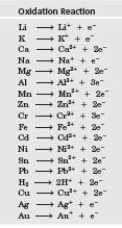A) H3O+(aq) + Cl-(aq) + Na+(aq) + OH-(aq) → Na+(aq) + Cl-(aq) + 2H2O(l)
B) HCl(aq) + NaOH(aq) → NaCl(aq) + H2O(l)
C) H3O+(aq) + OH-(aq) → 2H2O(l)
D) none of these
Correct Answer

verified
Correct Answer
verified
Multiple Choice
When comparing the strength of two weak acids which factor do we use to determine which is the stronger of the two?
A) the formula weights of the acids
B) the number of protons the acids can lose
C) the values of the pKa's of the acids
D) none of the above
Correct Answer

verified
Correct Answer
verified
Multiple Choice
Which base is sometimes used as a laxative?
A) LiOH
B) Mg(OH) 2
C) NaOH
D) NH3
Correct Answer

verified
Correct Answer
verified
Multiple Choice
Buffers which do not readily permeate cell membranes often involve which of the following?
A) only anions
B) only cations
C) only neutral molecules
D) zwitterions
Correct Answer

verified
Correct Answer
verified
Multiple Choice
Examine the activity series given below.  -Which of the following elements would be the least likely to release hydrogen gas (H2) upon reaction with water or acid?
-Which of the following elements would be the least likely to release hydrogen gas (H2) upon reaction with water or acid?
A) Ag
B) Ni
C) Al
D) Mg
Correct Answer

verified
Correct Answer
verified
Multiple Choice
What are the two acids in the following reaction? NH4+(aq) + HPO42-  NH3 + H2PO4-
NH3 + H2PO4-
A) NH4+ and HPO42-
B) NH4+ and NH3
C) HPO42- and H2PO4-
D) NH4+ and H2PO4-
Correct Answer

verified
Correct Answer
verified
Multiple Choice
When carrying out a titration which of the following situations is most desirable?
A) The equivalence point is reached before the end point.
B) The equivalence point corresponds to the end point.
C) The equivalence point is reached after the end point.
D) All of the above are equally acceptable.
Correct Answer

verified
Correct Answer
verified
Multiple Choice
Which of the following is the conjugate base of H2PO4-?
A) H3PO4
B) HPO42-
C) PO43-
D) OH-
Correct Answer

verified
Correct Answer
verified
Multiple Choice
Which of the following is the conjugate base of HPO42-?
A) H3PO4
B) H2PO4-
C) PO43-
D) OH-
Correct Answer

verified
Correct Answer
verified
Multiple Choice
Which of the following buffers will have the lowest pH?
A) a solution containing 0.20 M HC2H3O2 and 0.20 M NaC2H3O2
B) a solution containing 0.25 M HC2H3O2 and 0.15 M NaC2H3O2
C) a solution containing 0.15 M HC2H3O2 and 0.25 M NaC2H3O2
D) They all have the same pH.
Correct Answer

verified
Correct Answer
verified
Multiple Choice
Which of the following can be characterized as a strong base?
A) 0.001 M KOH
B) 3.0 M NH3
C) both a and b
D) neither a nor b
Correct Answer

verified
Correct Answer
verified
Multiple Choice
Which of the following is a triprotic acid?
A) HCl
B) HNO3
C) H2SO4
D) H3PO4
Correct Answer

verified
Correct Answer
verified
Multiple Choice
Which of the following species has the largest concentration in buffering systems of human blood?
A) H2CO3
B) HCO3-
C) H2PO4-
D) HPO42-
Correct Answer

verified
Correct Answer
verified
Multiple Choice
When NH3 is dissolved in water which of the following is true of the equilibrium which is established as represented below? NH3(aq) + H2O(l)  NH4+(aq) + OH-(aq)
NH4+(aq) + OH-(aq)
A) It lies virtually completely to the left.
B) It lies slightly to the left.
C) It lies virtually completely to the right.
D) It lies slightly to the right.
Correct Answer

verified
Correct Answer
verified
Multiple Choice
Which of the following is formed when a strong acid reacts with dimethylamine, (CH3) 2NH?
A) CH3NH3
B) CH3NH3+
C) (CH3) 2NH2+
D) None of these, no reaction occurs.
Correct Answer

verified
Correct Answer
verified
Multiple Choice
Which of the following is the net ionic equation for the reaction of the weak acid HC2H3O2 with the weak base NH3?
A) HC2H3O2(aq) + NH3(aq) → NH4C2H3O2(aq)
B) HC2H3O2(aq) + NH3(aq) → C2H3O2-(aq) + NH4+(aq)
C) H3O+(aq) + NH3(aq) → NH4OH(aq)
D) H3O+(aq) + C2H3O2-(aq) + NH3(aq) → NH4+(aq) + C2H3O2-(aq) + H2O(l)
Correct Answer

verified
Correct Answer
verified
Multiple Choice
Hydrocyanic acid, HCN, is a weak acid. Which of the following is the correct expression for the Ka of hydrocyanic acid?
A) [H3O+][HCN]/[CN-]
B) [H3O+][CN-]/[HCN]
C) [HCN]/[ H3O+][CN-]
D) [HCN][CN-]/[ H3O+]
Correct Answer

verified
Correct Answer
verified
Multiple Choice
According to Arrhenius which species is associated with all acids?
A) H3O+
B) OH-
C) H2O
D) none of these
Correct Answer

verified
Correct Answer
verified
Multiple Choice
In an aqueous solution the [H3O+] is 2.0 x 10 -6 M. What is the [OH-]?
A) 5.0 × 10-9 M
B) 1.0 × 10-7 M
C) 2.0 × 10- 6 M
D) 1.0 × 108 M
Correct Answer

verified
Correct Answer
verified
Multiple Choice
The end point of an acid-base titration corresponds to which of the following?
A) The point where equal volumes of acid and base have been used.
B) The point where the acid and base have been added in proper stoichiometric amounts.
C) The point where a pH indicator changes color.
D) none of the above
Correct Answer

verified
Correct Answer
verified
Showing 141 - 160 of 197
Related Exams